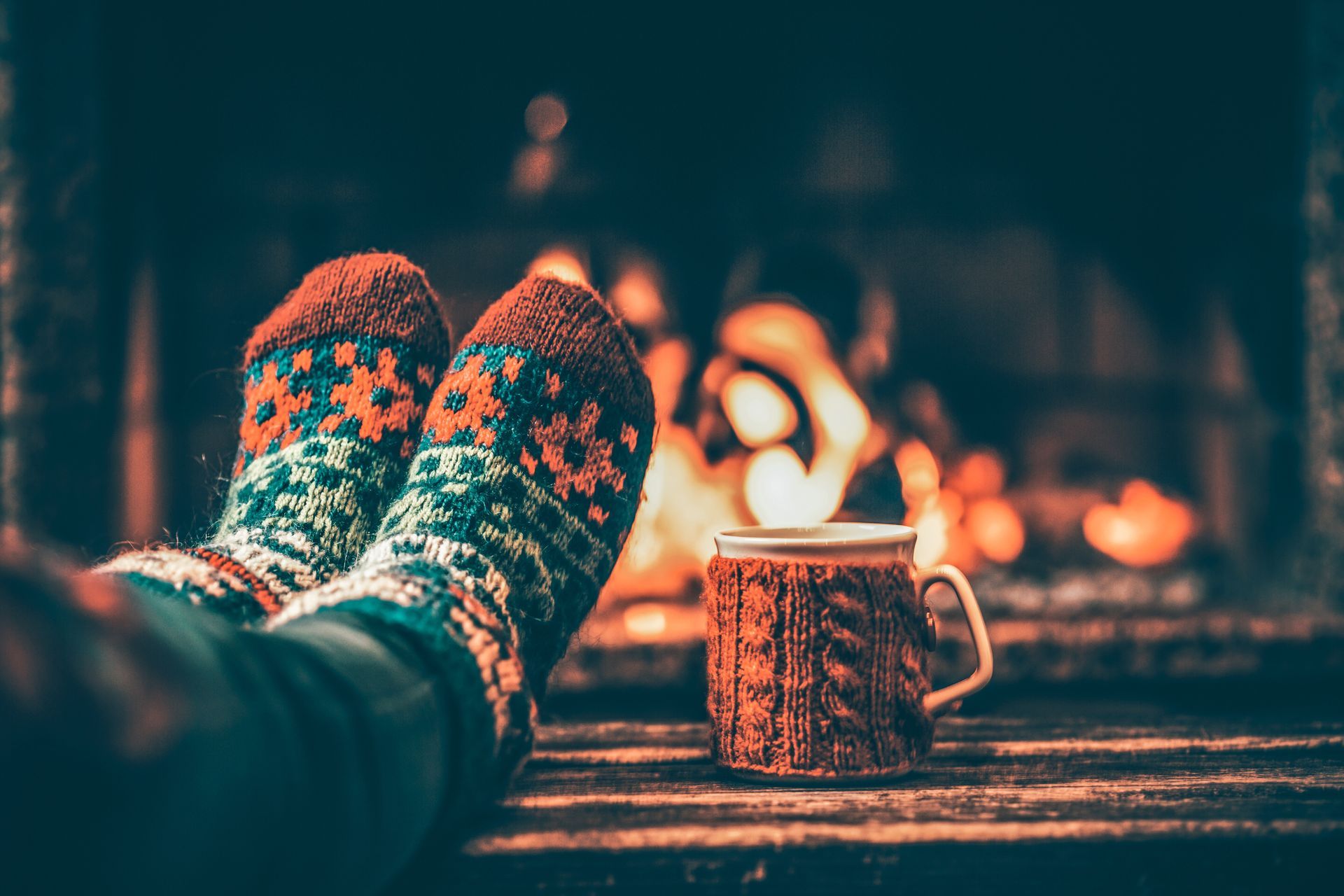Blog
Blog
Learn About Vascular Care in the Vail Valley Community

December 7, 2024
How Cold Weather Affects Your Circulation (And What You Can Do About It) Ah, winter—cozy sweaters, hot cocoa, and that bracing chill in the air. But while snowball fights and snug scarves may be fun, cold weather isn't always kind to your body, especially when it comes to circulation. If your fingers and toes start feeling like tiny icicles or your legs ache after a chilly stroll, you’re not alone. Let’s dive into why winter can make your circulation work overtime and what you can do to keep your blood flowing smoothly this season. What Does Cold Weather Do to Your Circulation? W hen the temperature drops, your body kicks into survival mode, narrowing blood vessels near the skin's surface to keep your core warm. This process, called vasoconstriction , reduces blood flow to your extremities (hands, feet, nose, and ears), making them feel cold, numb, or even tingly. If you already have circulation issues, like peripheral artery disease (PAD) or chronic venous insufficiency (CVI) , winter can be especially tough. Cold weather increases your blood pressure, which can put more strain on your heart and blood vessels. Plus, the reduced blood flow can make symptoms like pain, swelling, or cramping worse. Signs Your Circulation May Be Struggling This Winter Are you noticing any of these symptoms? They might be signs your circulation needs a little TLC: Cold hands and feet (even when indoors) Numbness or tingling in your extremities Leg pain or cramping , especially when walking Swelling in your legs or feet Skin color changes , like pale or bluish fingers and toes If any of these sound familiar, don’t brush them off. Poor circulation can lead to more serious health issues if left unchecked. How to Keep Your Circulation Flowing in Cold Weather Ready to give your circulation a winter boost? Here are some fun, practical tips to keep the blood pumping from your head to your toes: 1. Layer Up (But Don’t Overdo It) Bundle up in warm, breathable layers to keep your body temperature steady. Pro tip: Wool socks and gloves can do wonders for chilly fingers and toes! 2. Stay Active Yes, it’s tempting to hibernate, but even light exercise can work wonders for your circulation. Try a brisk walk, yoga, or dancing around your living room to your favorite playlist. 3. Sip on Warm Drinks A hot cup of tea or cocoa isn’t just comforting—it can help dilate blood vessels, improving circulation. Plus, staying hydrated is key! 4. Elevate Your Legs If swelling is an issue, try propping up your legs with a pillow while relaxing. It helps blood flow back to your heart more easily. 5. Get Regular Check-Ups If you have a history of circulation issues, now’s the time to visit your vascular specialist. They can check for underlying conditions and recommend treatments to keep you healthy all winter long. When to See a Specialist Sometimes, poor circulation is more than just a winter inconvenience—it can signal a serious health problem. If you’re dealing with persistent pain, discoloration, or swelling, don’t wait to get it checked out. At Ascent Vascular Specialist , our team is here to help you tackle circulation issues with expert care and personalized solutions. Warm Up to Better Circulation Winter may be chilly, but your health doesn’t have to suffer. With a few smart habits and a little help from your vascular specialist, you can keep your circulation flowing and enjoy all the season has to offer. If you’re concerned about your circulation, don’t hesitate to reach out to Ascent Vascular Specialist . Schedule a consultation today, and let’s get you back to feeling your best—no matter the weather! Ready to take control of your circulation this winter? Contact us today and start your journey toward better vascular health!

November 7, 2024
As the holiday season kicks into high gear, you may be busy planning festive gatherings, shopping for gifts, or mapping out trips to visit loved ones. But if you suffer from varicose veins, this time of year may also bring an unwelcome guest—leg pain, swelling, and discomfort. At Ascent Vascular Specialist , we want you to feel your best so you can fully enjoy the holiday season. Let’s explore what causes varicose veins, effective treatment options, and prevention tips to keep your legs healthy and happy. What Are Varicose Veins? V aricose veins are enlarged, twisted veins often visible just under the skin. They can develop when the valves in your veins, which work to keep blood flowing in one direction, become weak or damaged. As a result, blood pools in the veins, causing them to stretch and twist. While varicose veins can appear anywhere, they’re most common in the legs and feet. Common Causes of Varicose Veins Genetics: If your parents or grandparents had varicose veins, there’s a higher chance you may develop them. Age: The risk increases as you age and your veins naturally lose elasticity. Pregnancy: Hormonal changes and increased blood volume during pregnancy can contribute to varicose veins. Prolonged Standing or Sitting: Working in a job that requires you to stand or sit for extended periods puts extra pressure on your leg veins. Obesity: Excess body weight adds strain on your veins, making them more susceptible to damage. Symptoms to Watch Out For Varicose veins are not just a cosmetic concern. They can cause symptoms such as: Aching or throbbing pain Heaviness in the legs Swelling, particularly around the ankles Itchy or dry skin near the affected veins Muscle cramps or restless leg syndrome The severity of these symptoms may vary, but if you experience significant discomfort, it is essential to consult a vascular specialist . When to See a Specialist. Effective Treatments for Varicose Veins At Ascent Vascular Specialist , we offer advanced, minimally invasive treatments to relieve your symptoms and improve the appearance of varicose veins. Here are some options: 1. Sclerotherapy This involves injecting a solution into the affected vein, causing it to collapse and eventually fade away. It’s a quick, in-office procedure with minimal downtime. 2. Endovenous Laser Therapy (EVLT) EVLT uses laser energy to close off problematic veins, rerouting blood flow to healthier veins. The procedure is efficient and effective and typically performed under local anesthesia. 3. Radiofrequency Ablation (RFA) Similar to EVLT, RFA uses radiofrequency energy to heat and close off varicose veins. It’s a safe and highly effective way to reduce pain and improve vein appearance. 4. Vein Stripping and Ligation Although less common now, this surgical approach may be necessary for severe cases. It involves removing or tying off the affected veins. Holiday Tips for Preventing Varicose Veins While some risk factors for varicose veins are unavoidable, you can take steps to minimize your discomfort and prevent new veins from forming—especially during the holiday season when standing, sitting, and indulging are common. 1. Stay Active Walking, stretching, or even dancing at holiday parties can promote healthy blood flow. Consider taking a brisk 15-minute walk after large meals to aid circulation. 2. Watch What You Eat The holidays often bring plenty of salty and sugary treats. Excess sodium can cause fluid retention and worsening leg swelling. Try to balance holiday indulgences with fruits and vegetables that support vein health. 3. Wear Compression Stockings If you know you’ll be on your feet often, consider wearing compression stockings. They can help improve circulation and reduce the achiness caused by varicose veins. 4. Elevate Your Legs Whenever you get a chance, elevate your legs to help reduce swelling. This is especially useful after long shopping trips or holiday travel. 5. Stay Hydrated Drinking water not only helps keep your blood vessels healthy but also aids in maintaining good circulation. When to See a Vascular Specialist If lifestyle changes and home remedies aren’t easing your symptoms, it might be time to seek professional care. At Ascent Vascular Specialist , we tailor our treatment plans to each patient’s unique needs. Early intervention can prevent complications, such as blood clots or ulcers, and help you feel more comfortable throughout the holidays and beyond. Conclusion Don’t let varicose veins put a damper on your holiday spirit. Understanding the causes and symptoms can help you be proactive about treatment and prevention. With a combination of healthy lifestyle choices and expert care from Ascent Vascular Specialist , you can keep your legs feeling great and focus on making holiday memories with your loved ones. Ready to learn more or schedule a consultation? Visit Ascent Vascular Specialist today and take the first step toward healthier veins. Meta Description : Varicose veins causing discomfort this holiday season? Learn about causes, effective treatments, and holiday prevention tips from Ascent Vascular Specialist.

August 28, 2024
Discover the importance of ultrasound for vascular care at Ascent Vascular. Learn how our advanced ultrasound services diagnose, guide, and monitor various vascular conditions, ensuring safe, effective, and personalized treatment. Visit Ascent Vascular to explore our state-of-the-art ultrasound lab and dedicated team.
Office Address:
1140 Edwards Village Blvd. B204
Edwards, CO 81632-5562
Mailing Address:
1300 N. Frontage Rd. W. #4994
Vail, CO 81657-9998
© 2025
All Rights Reserved | Ascent Vascular Specialists and Vein Center
Website Design by Infinity Medical Marketing | Privacy Policy




